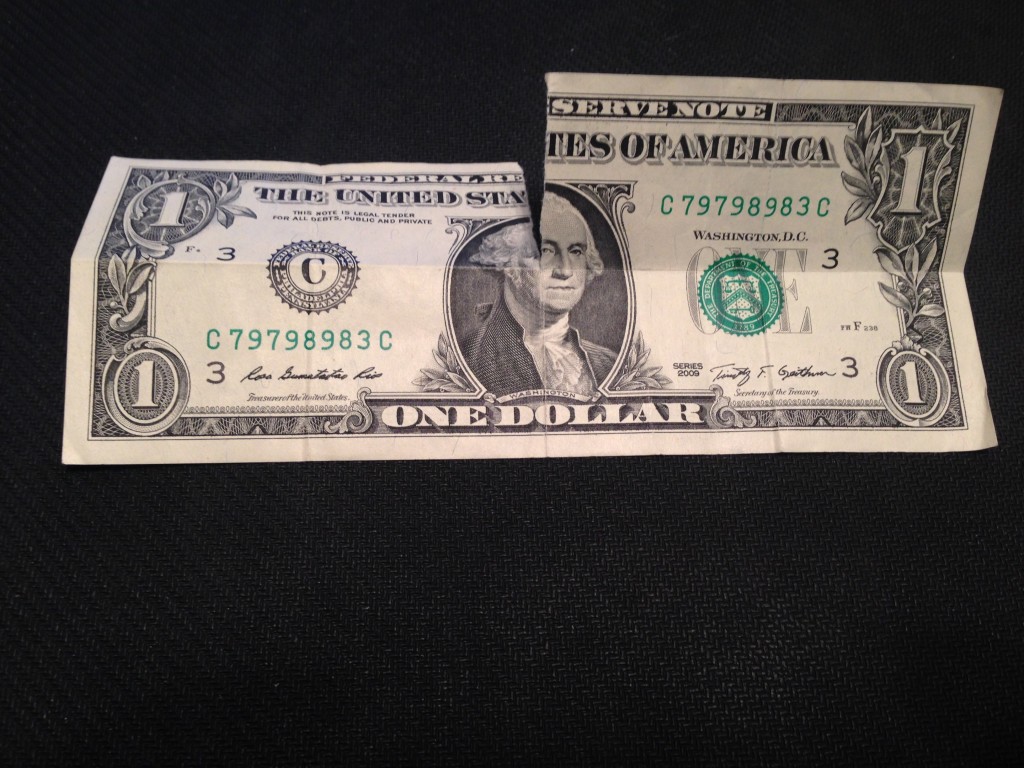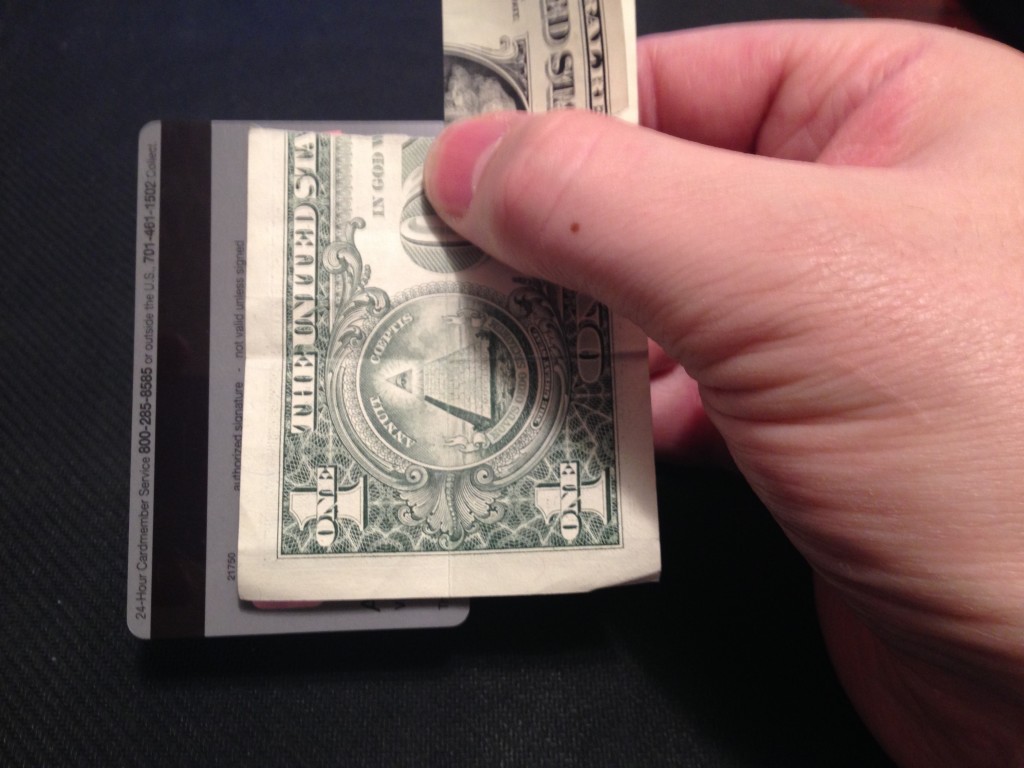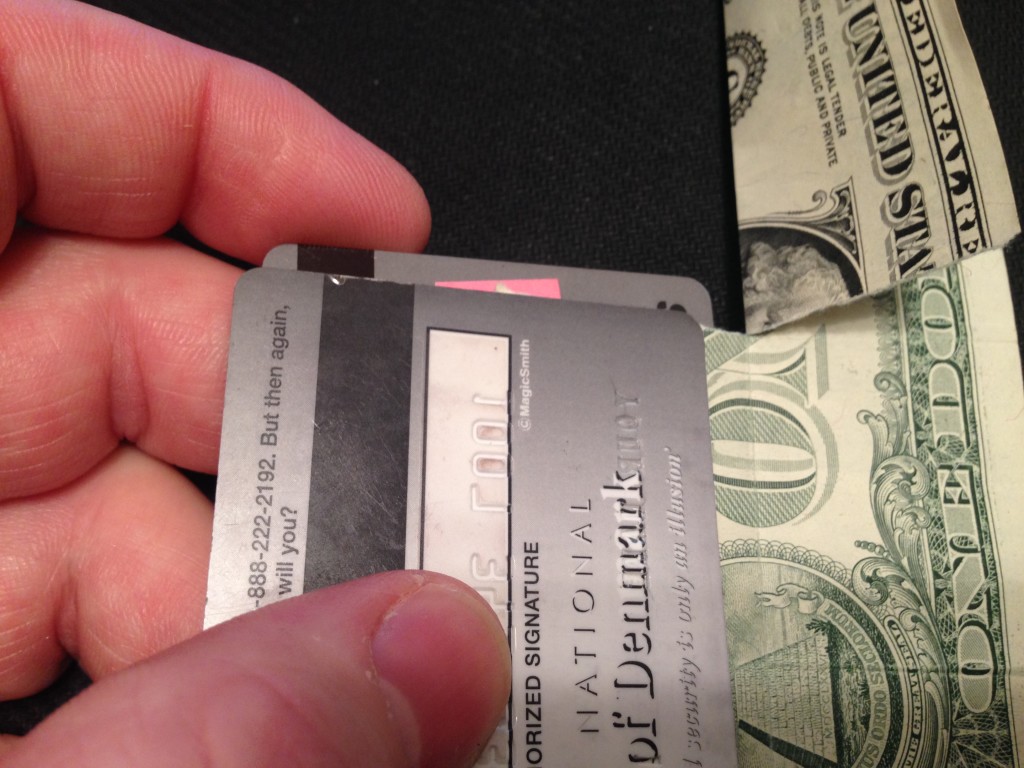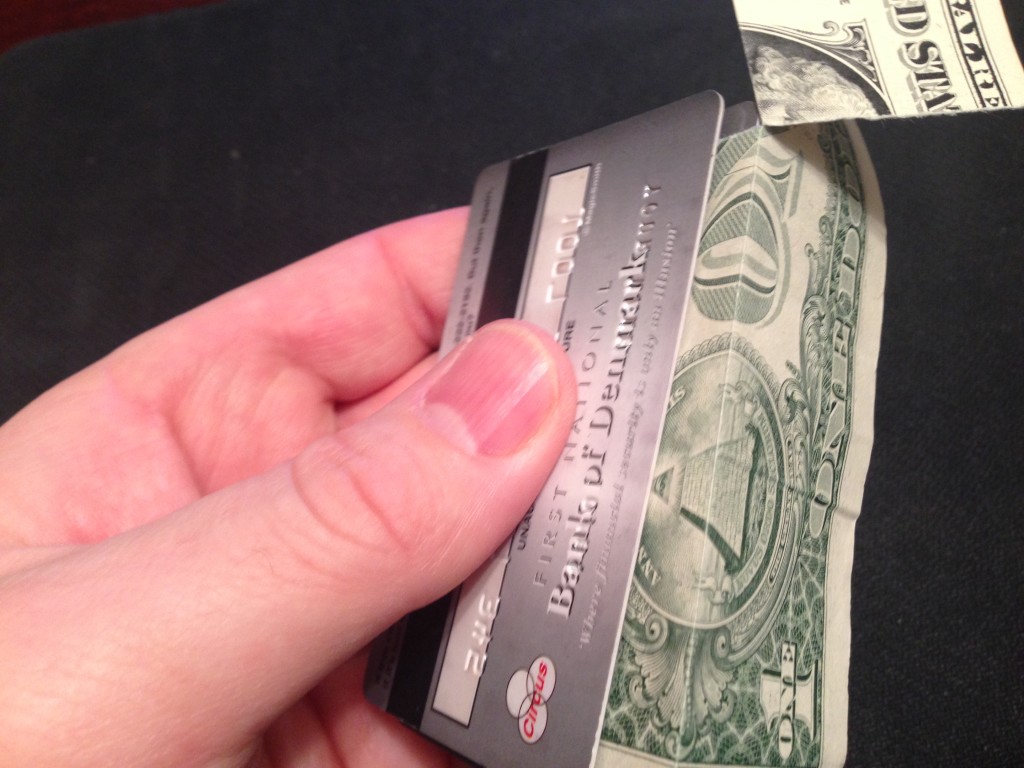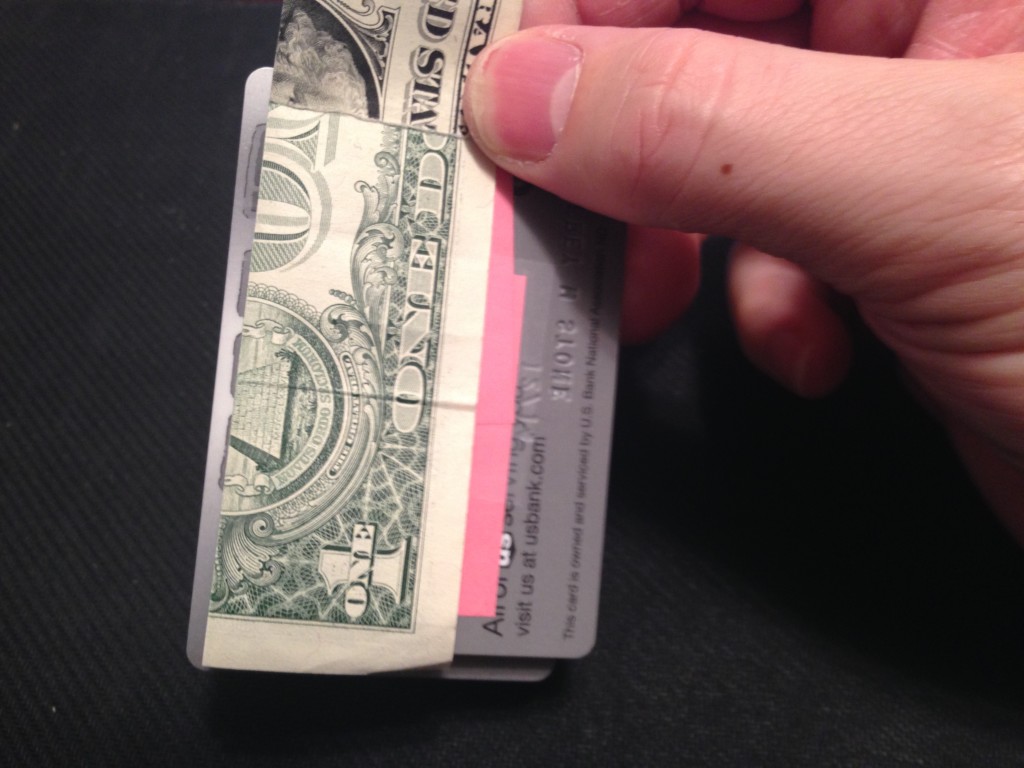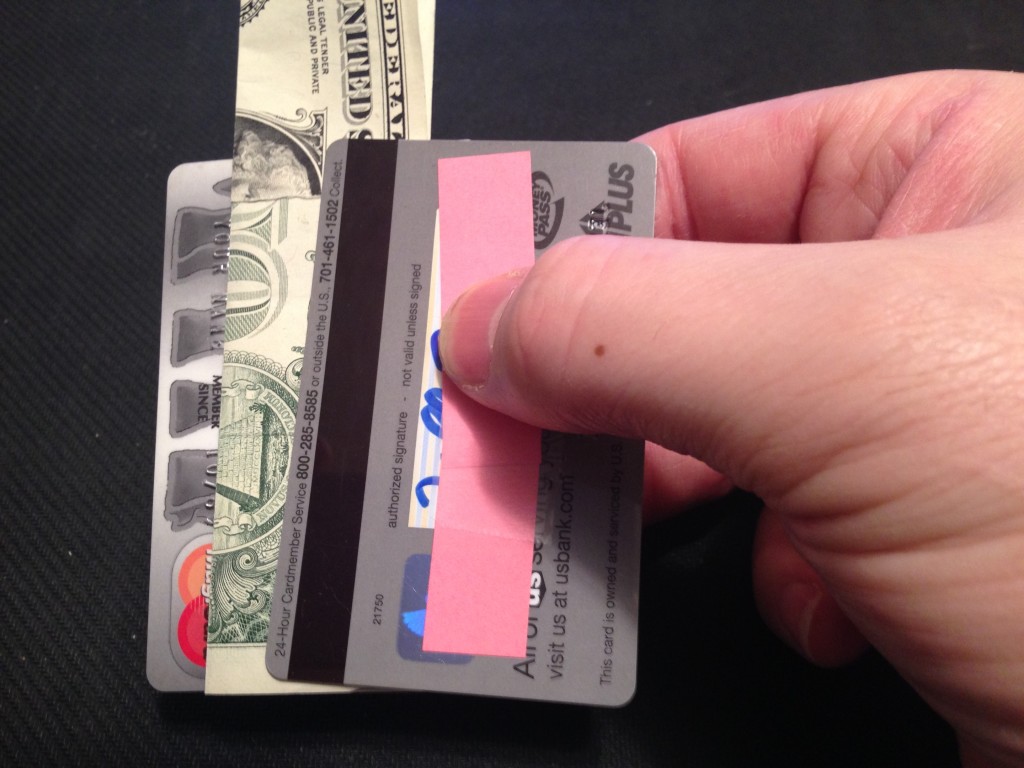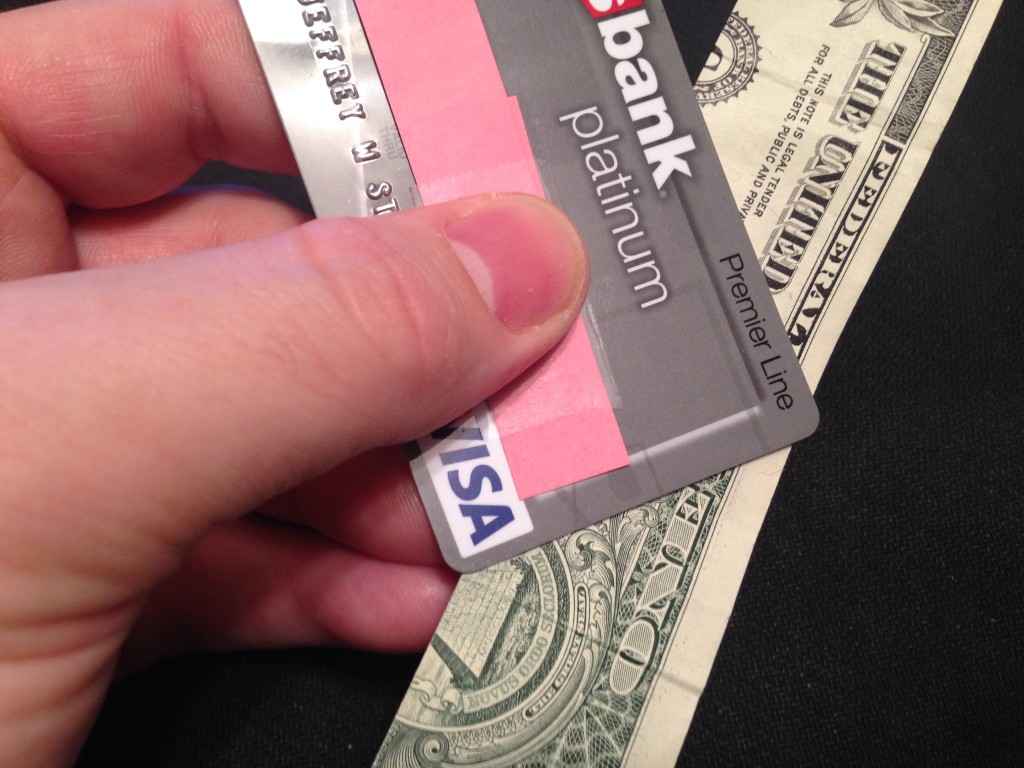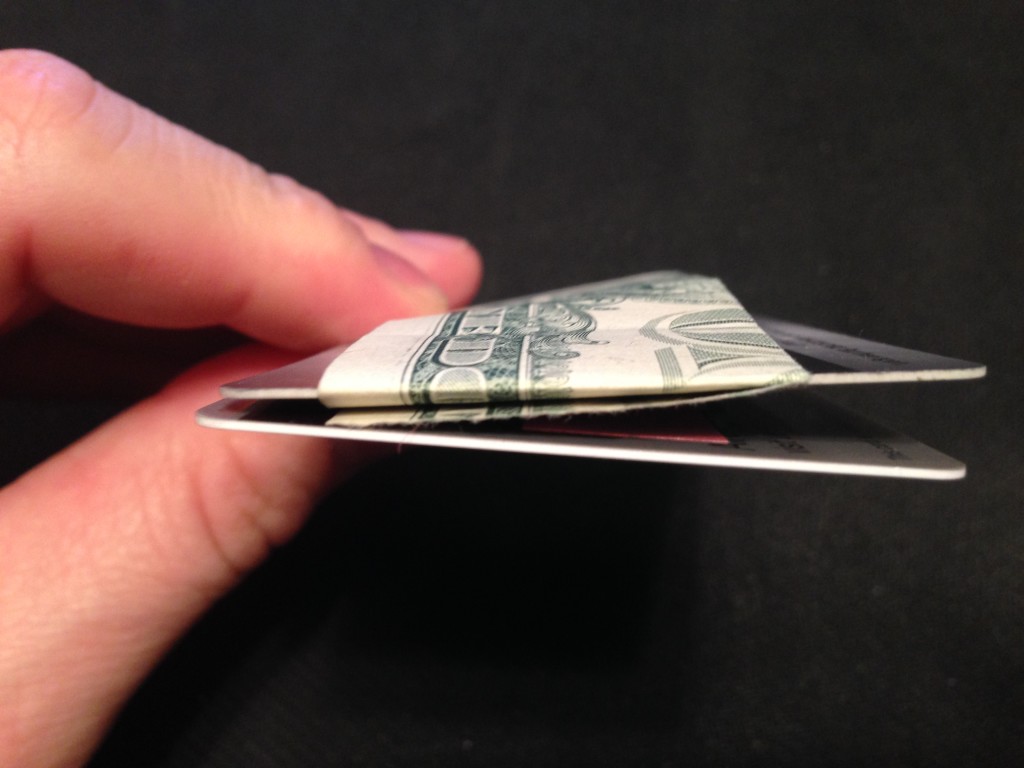Billwarp
Introduction
It’s seems to be a pattern with me lately . . . I keep trying to create methods/handling ideas for effects that I’m not a fan of. Last month we dealt with the Multiple Card Revelations effect. This month, I’m taking on Roy Walton’s Cardwarp.
Originally, I wanted to come up with a way to do the effect with two one-dollar (or whatever denomination) bills. However, due to the dimensions of the dollar bill, the secret cannot be hidden by another dollar bill. The proportion of the length to width is not quite right.
For a while I just felt like it couldn’t be done. I tried folding the bill in weird ways, but to no avail. The problem is that I wanted this to be something that could just be carried in my wallet. I didn’t want to carry around any cards to make it work.
Finally, I stumbled on the idea of using two credit cards to sandwich the dollar bill. I tested the dimensions, and it works perfectly. After some fiddling around I came up with the following.
Effect
A dollar bill is folded in half lengthwise. It is sandwiched between two credit cards. As the bill is pushed through the two credit cards, it emerges on the other side inside-out. This is repeated a time or two. Then the bill ripped in half showing that half of it was inside-out.
Credits
This is, obviously, just Cardwarp with different props. As far as I know, there are only two other published sans-cards version of this effect. The Cardwarp Tour by Jeff Pierce is, as far as I know, the most comprehensive study of the effect, its origins and its variations. In that book, there are a handling ideas using a dollar bill, but in most cases, the dollar bill is used as the magic “portal” where the card turns inside-out.
The two effects that do not use playing cards are Warp 9 by Mike Powers and Inside Out by Richard Osterlind. The Powers version uses a dollar bill as the portal and a business card as the object to be warped. Osterlind’s effect is the only one where the bill itself warps. However, it’s a completely different kind of effect and method. It’s a routine using a single bill that ends with a mis-made bill. Having said all that, I’m 99.999999% confident that the effect you are reading is original with me.
Method
First, a note: pink strips of paper on the credit card in the images below have nothing to do with the effect. They are just there to obscure my credit card number.
Moving on: start by having a dollar bill pre-torn in your wallet ready to go. Remove two credit cards from your wallet and the bill and show it on both sides, concealing the tear. Fold it in half length-wise, keeping the torn side toward you (see image below).
Holding the bill in your right hand with your thumb over the tear, use your left hand to place the two credit cards in front of the bill to the left with the front-most (i.e., closest to the audience) card down-jogged and left jogged. Having the cards jogged like this gives more of a screen to prevent the next move from flashing.
Slightly roll your right thumb upwards to release the bottom part of the bill below the tear. With the left thumb, open the bottom half of the dollar bill (see image below – note: the front-most card is removed from the image to clearly show the relationship of the rear-most card and the dollar).
Next, align the bill so that it is fully hidden by the card nearest you. Place the front-most card on top of the bill thus sandwiching the bill between the two credit cards (image below – note: the bill is slightly jogged to the right for clarity only).
Holding the top of the ripped portion of the bill against the rest of the dollar with your right thumb, grab the two cards with your left hand from the left side and pivot them around into the front of the bill. The ends result is the secretly unfolded part of the bill is sandwiched between the two cards, and the rest of the bill (still folded length-wise) is behind both cards (image below – note: the right hand is removed for clarity and because it’s holding the camera).
Immediately slide the rear-most (i.e., closest to your) card to the right about a half of an inch while maintaining the right thumb on the tear. Transfer everything to the left hand placing your left thumb across the entire tear, keeping it flat against the bill and cards (image below).
With the right hand, grab the rear-most card and slide it out to the left; show it on both sides, and place it on top of the bill. The situation, now, is the two credit cards are sandwiching the dollar bill which is folded with the top part (i.e., above the tear) of the fold toward you and the bottom part (i.e., below the tear) of the fold is folded toward the audience. The secret nature of the bill is, of course, hidden between the credit cards (image below – note: the cards are spread for clarity only).
This whole series of actions only takes a few seconds. Now you are in position to push the dollar bill through the portal (i.e., the credit cards). As it emerges on the other side, it will appear to be turning inside-out between the cards. Push it back and forth as many times as fits your presentation. When you’re just about to finish, you can do the somewhat standard corner display where you bring the center of the bill to the corners of the credit card showing both sides clearly with the bill inside-out (image below).
After that moment has sunk in, bring the bill back to being parallel to and sandwiched in the cards. Push it all the way to the left again. Pull it slightly farther out of the cards, just to the point where the tear is no longer hidden inside the cards. However, it’s covered by your left hand. You want to make sure that you do this so that the tear is outside of the card on the audience’s side. However, just before the tear would expose itself, fold the bill toward the audience and up against the front-most card (image below – note: this is a very “exposed” view. The dollar should be facing the audience, and the opening between the cards would actually be on your left concealed by your left fingers).
Then unfold it while keeping your left index finger in front covering the tear with the left thumb directly behind the left index finger behind the bill. You’re in position to tear the bill. With the right hand, pinch the two cards together and tear back toward yourself as the left hand tears forward. If done properly, this will tear the bill exactly at the point of the original half-tear. Immediately spread the two cards to reveal the other half of the bill between the cards. This makes a nice display of the two halves one folded one way and the other folded the other way.
Below is a video of the entire handling. Note that this is not a “performance” but rather a slowed down walk through of the handling from the audience’s perspective.
Presentation
This kind of effect, with these props lends itself to interesting presentation ideas, so let’s take a look at a few.
The Scam
Pull out your debit/credit cards and make the claim that you don’t need to go to an ATM to get money.
However, since I’m not at my bank’s ATM, there’s a transaction fee of a dollar.
Get the prepared dollar out of your wallet, and set it up as directed above. Then claim that as you push it through, a $20 bill will come out the other side. However, as you push it through, a $20 doesn’t come out. Instead your dollar gets turned inside out.
Maybe this is one of those scam ATMs that just steal your account number and PIN.
In anger, you “try to take the bill back,” but it “accidentally” rips as you take it out. In this presentation, if you choose to do the diagonal display, you’ll want to take on the attitude of confusion like you’re trying to figure out what the heck is going on, so you start moving it around trying to “figure it out.” Then when you display it at the corner of the cards, you look just as confused and surprised as everyone else.
Tricky Bank Teller
This is similar to the The Scam, but this time it’s the bank teller trying to scam you rather than the ATM. Simply claim that the teller tried to convince you that he was giving you two dollars instead of one. The idea of this is similar to the old gag where you claim to have two quarters in your pocket. You pull out one quarter and say, “one.” Then you put your hand (with the quarter) back in your pocket. You come out with “another” quarter and say, “two.”
This is a gag often used when entertaining children. With the dollar bill, you claim that “here’s one dollar,” then after pushing it through you claim that here’s the other dollar. After the teller did this a couple of time (you claim) you tried to grab the bill to look at it, but it “accidentally” ripped. With this presentation, you would leave out the diagonal display.
Notes
The length of a credit card is about a half inch longer than half of the length of a dollar bill. This allows plenty of cover when pushing the bill through the cards. You’ll never be able to accidentally push the bill too far.
Also, since the dollar bill has a border, it’s okay if the bill peeks out a little bit on one side before you effect the change. It will just look like the bill is sticking out with nothing weird happening.
The advantage of this version over the original is that you probably already have two credit cards in your wallet, and you probably already have cash in your wallet. If you’re planning on doing this effect, you already have what you need. Just pre-tear one or two bills, and you’re all set.
One quick tip: when performing this, make sure that the raised numbers on the credit cards (i.e., the front of the cards) are on the outside. You want the back of the cards to be on the inside. It makes sliding the bill through much easier. The tear won’t snag on the raised numbers, and it’s just a much better surface in general . . . less friction.
Lastly, you may want to consider doing a restoration of the bill at the end. Before reading Osterlind’s effect, I also had the idea to use a mis-made bill. My idea was this: after tearing the bill in half and letting that sink in, I would then tear each half in half again, length-wise. Then using a bill switch, restore it, but it would end up as a mis-made bill.
I also considered just doing a bill switch with the two ripped pieces (without ripping them further). If you use The Scam presentation above, you could end with a bill switch that changes the torn $1 bill into a torn $20 bill (or a restored one).

